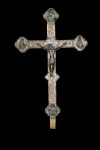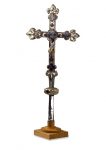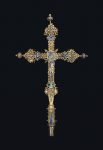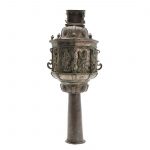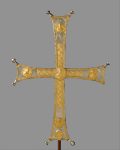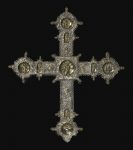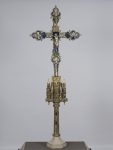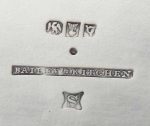Processional Crosses. A processional cross is a crucifix or cross which is carried in Christian processions. Such crosses have a long history: the Gregorian mission of Saint Augustine of Canterbury to England carried one before them “like a standard”, according to Bede. Other sources suggest that all churches were expected to possess one. They became detachable from their staffs, so that the earliest altar crosses were processional crosses placed on a stand at the end of the procession. In large churches the “crux gemmata”, or richly jewelled cross in precious metal, was the preferred style. Notable early examples include the Cross of Justin II (possibly a hanging votive cross originally), Cross of Lothair, and Cross of Cong. Reference: Wikipedia
An Italian part 16th century silver and gilt copper processional cross the main body of the cross with repoussé and relief designs of scrolling flowers and foliage, the quatrefoil terminals with applied silver (probably later) pierced plaquettes, each with a relief cast figure, the left terminal with the Virgin, the right with Saint John the Baptist, the upper with God the Father and the lower with Mary Magdalene, the centre with a figure of Christ (probably 19th century), the reverse with Saint Paul to the centre and the Bishop donor at the base, the upper terminal with an engraved plaquette inscribed ‘Nel tempo del Dō Thomasso Phenio Plē[b]ano de Santa Maria de Fematre 1562’, the left and right reliefs missing, later additions and restorations, 54.5cm high FOOTNOTES The text on the plaquette applied to the cross translates as “In the time of Master Thomas Phenio Parish Priest of St Maria of Fematre”. Provenance: From the Church of the Resurrection, Mirfield, given to the Community by a departed member, Fr Elwin Millard CR. in the 1930s.
Sold for £ 2,400 inc. premium at Bonhams in 2010
Processional cross, crucifix; silver-gilt; decorated with translucent enamels; base of cross is hexagonal in section and above it is large knop decorated with enamelled lozenges bearing arms of Hungary and of the Hedervari family; front with Christ in the round; both sides of cross decorated with quatrefoils of translucent enamel depicting on the front: Christ, the Virgin and St John, Adam rising from the tomb; reverse: Agnus Dei and symbols of the Evangelists; each arm terminates in fleur-de-lis. Made by: Peter Gallicus Date 1330-1350 (circa)
Reference: © The Trustees of the British Museum
A SILVER-GILT AND TRANSLUCENT ENAMEL PROCESSIONAL CROSS SPANISH, CIRCA 1370-1400 recto with a parcel-gilt silver corpus figure of Christ with a central enamel plaque depicting the Virgin Mary and the twelve disciples in prayer, and four enamel plaques at the points of the cross depicting the Virgin, St John, Christ’s resurrection and Mary Magdalene in prayer; verso with a parcel-gilt silver group of the Virgin and Child with four enamel plaques at the points of the cross with the symbols of the Evangelists
Sold for GBP 206,500 at Christies in 2015
Processional cross cluster in silver, 16th Century.
With eight embossed saints in the central body. With unidentified hallmarks. 40x15x15 cm. 1.984 kg (without the wooden core).
Sold for €1,050 at Balclis in 2019
Processional Cross Date: ca. 1000–1050 Culture: Byzantine Medium: Silver, silver-gilt
Elaborately decorated crosses were widely used in religious, military, and imperial processions during the Middle Byzantine era. Often, as here, inscriptions in Greek identify the holy figures depicted in portrait busts. On the front of this cross, the central medallion contains a bust of Christ. The archangels Michael and Gabriel, the guardians of heaven, are pictured above and below him. To left and right are the traditional intercessors on behalf of humankind: the Virgin Mary, Mother of Christ, and John the Forerunner (Saint John the Baptist). The inscription at the base on the back of the cross identifies it as the votive gift (supplication) of a Bishop Leo. It was probably offered in honor of Saint Thalelaios, a physician, who is shown in the back central medallion with the symbols of his profession, a medical case and the pointed surgical tool known as a lancet. To the sides are saints Nicholas and John Chrysostom, two of the most important early church fathers. The archangels Uriel and Raphael appear at top and bottom. A homily (sermon) attributed to Saint John Chrysostom describes crosses as “power for those who are ill” and “the purification of sickness”; the donation of this cross was perhaps connected to an illness. The cross may have been used in the ceremony for the purification of water, since Thalelaios, a late third-century martyr, is one of the saints named in that service.
Reference: The Metropolitan Museum of Art
Cross (cruz guión) Spanish Colonial 1721
The equal-sided cruciform structure surmounts a hollow cylinder that narrows toward the cross. The rod, which bears traces of gilding, has been lightly chased with foliate decoration. A baluster with scrolled projections separates the rod from the cross. Four chased “shooting” stars emanate from between each of the cruciform arms. A circular central boss is decorated on one side with a chased image of the Virgin Mary who, with elbows bent and hands together in an attitude of prayer, displays stylized roses in the folds of her cloak. The image is surrounded by engraved text. On the reverse, a removable circular frame also engraved with text holds a chased disk bearing the image of the Adoration of the Host, in which a consecrated Host, engraved “IHS” with a cross, floats above a chalice. A pair of angels flanks the chalice, and the scene is surrounded by rays of sunlight.
Reference: Museum of Fine Arts Boston
Spanish, last quarter 16th century PROCESSIONAL CROSS parcel-gilt silver height 33 3/4 in.; 85.7 cm., on metal stand
Sold for 75,000 USD at Sothebys in 2018
Wooden foundation covered with thin sheets of silver-gilt chased with a scroll of foliage, and with cast crocketed edging. At the end of each arm is an engraved quatrefoil plaque, formerly enriched with translucent enamel; where the arms intersect with the cross upright there are engraved square plaques. On the front of the cross, a cast applied silver-gilt figure of the crucified Christ; on the reverse a cast applied silver-gilt figure of Christ in Majesty.
This is a rare surviving example of a double-armed processional cross from early-fifteenth-century Barcelona. Its special form indicates it was made for a cathedral, the church which contains the official seat of the bishop in a diocese. The engraved silver plaques would originally have been enamelled with bright, translucent colours. On the front of the cross, scenes of Christ’s final hours and of His Resurrection are arranged above the cast and applied figure of the crucified Christ. The plaque at the top of the cross which depicts a pelican plucking at its breast is symbolic of Jesus’s sacrifice. On the back of the cross is the cast and applied figure of Christ in Majesty, His hand raised in blessing, surrounded by the symbols of the four Evangelists who recorded His life in the Gospels. The awkward proportions of this figure suggest it may not be original to the cross, while the large knop typically found at the base of processional crosses (to facilitate carrying them) is missing.
Reference: © Victoria and Albert Museum
Processional Cross with Crucified Christ and God the Father
Crosses mounted on a staff were prominent in Catholic religious processions in the Renaissance, as they were in the Middle Ages and continue to be. The same maker’s mark from Zaragossa has been stamped into the metal multiple times. It appears to be identical to one in use in Zaragossa, Spain, between 1560-90 but it is not clear when the mark was first used. This cross exemplifies the combination of enameling and fine metalwork, the base of which suggests a church, that are consistent with an origin in a Zaragossa workshop in the later 15th and early 16th century. The gilded silver figures of Christ and especially of God the Father on the reverse are sensitively modeled and complemented by the surrounding enameled plaques. The front features the sorrowing Virgin and John the Evangelist with the Four Evangelists on the reverse. The supposed date of the marker’s mark and the style of the components, especially the sculpted figures and the enamel work, are at odds. The possibilities appear to be: the city mark that seems identical with the stamp on the Walters’ piece was used earlier than 1560, the stamp actually records an earlier city mark of which we are unaware, the stylistic analysis is incorrect, or possibly components of the cross were reassembled at a date long after the original creation and at that time various parts were stamped. There are some serious losses, but a thorough technical investigation and conservation treatment in 2012 brought back much of the original splendor. This processional cross was the subject of a year-long study and conservation treatment funded by the Samuel H. Kress Foundation, through an FAIC Kress Conservation Fellowship, from 2012-2013. DATE DESCRIPTION NARRATIVE 6/01/2012 Examination cleaned; coated; examined for condition; examined for technical study; loss compensation; mounted; other; x-ray florescence Lost and Found: The Secrets of Archimedes. The Walters Art Museum, Baltimore. 2011-2012. Acquired by Frédéric Spitzer, Paris; Spitzer Collection Sale, Paris, April 17-June 16 1893, no. 303. Purchased by Charles Davis, London. Purchased by Raoul Heilbronner, Paris; purchased by Henry Walters, Baltimore, 1909; by bequest to Walters Art Museum, 1931. Acquired by Henry Walters, 1909
Reference: The Walters Art Museum
